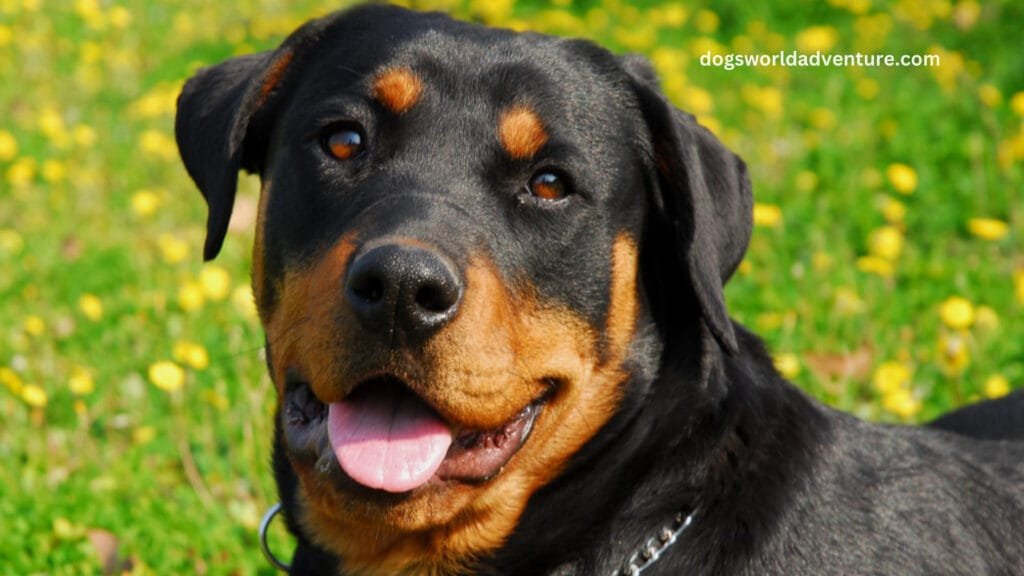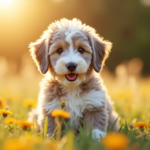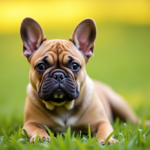The Rottweiler is a strong, loyal, and protective dog that has a long history as a working breed. Originally used by the Romans to herd cattle, this breed later became known for its skills in guarding and pulling carts. Today, Rottweilers are loved for their intelligence and dedication to their families. They make great family pets when trained properly, and they are known for being both affectionate and watchful over their loved ones.
In this article, we’ll cover everything you need to know about Rottweilers, including their history, personality, training needs, exercise requirements, grooming tips, and diet. We’ll also clear up some common misconceptions about the breed and provide answers to frequently asked questions. Whether you’re thinking of getting a Rottweiler or just want to learn more about this amazing dog, you’ll find all the information you need right here.
Quick Facts About Rottweiler
- Breed Origin: Ancient Roman herding dogs, later developed in Germany.
- Size: Males weigh 95-135 pounds; females weigh 80-100 pounds.
- Lifespan: 8 to 10 years.
- Temperament: Loyal, protective, confident, and affectionate with family.
- Training: Intelligent and easy to train, but requires early socialization.
- Exercise Needs: At least 1 hour of daily exercise.
- Grooming: Low-maintenance; moderate shedding, with brushing once or twice a week.
- Common Health Issues: Hip dysplasia, elbow dysplasia, and heart problems.
- Good with Kids: Yes, with proper training and supervision.
- Ideal Role: Family pet, guard dog, or working dog.
History of the Rottweiler
The Rottweiler’s roots go back thousands of years. Their ancestors were Roman herding dogs that helped move cattle and guard livestock. When the Romans traveled through Europe, these dogs worked alongside them. They eventually settled in a town called Rottweil in Germany, where they earned their name. The town of Rottweil became known for its butchers, and the Rottweiler became known as the “Butcher’s Dog.”
These dogs were responsible for driving cattle to market and pulling carts loaded with meat. They were also tasked with guarding their owner’s money, which was often tied around their necks in purses. This role made the Rottweiler not only a working dog but also a protector.
As time went on and railroads replaced cattle drives, the need for Rottweilers as working dogs declined. However, their protective instincts and loyalty made them excellent guard dogs. They became popular in police and military work due to their strength, intelligence, and ability to follow commands.
Physical Characteristics of the Rottweiler
The Rottweiler is a large and powerful dog with a muscular build. They have a short, thick coat that is black with tan markings on their face, chest, and legs. Their eyes are dark and almond-shaped, giving them an alert and confident expression. The ears are medium-sized and hang down, which adds to their distinctive look.
Most Rottweilers weigh between 80 and 135 pounds, with males generally being larger than females. Males also tend to be more muscular, while females have a slightly more slender build. Rottweilers are known for their broad chests and sturdy bodies, which give them the strength to perform tasks like pulling heavy loads or guarding property.
Despite their strong appearance, Rottweilers are surprisingly agile. Their compact and muscular bodies allow them to move quickly and with purpose, making them effective working dogs and excellent athletes.
Rottweiler Temperament and Personality
One of the most important traits of the Rottweiler is its temperament. Rottweilers are known for being loyal, protective, and confident. They form strong bonds with their families and will go to great lengths to protect their loved ones. This makes them excellent guard dogs, but it also means they need proper training to ensure they don’t become overly aggressive.
Rottweilers are naturally calm and confident. They don’t tend to bark without reason, and they remain composed in most situations. However, if they sense danger or feel that their family is being threatened, they will react quickly to protect those they care about.
Despite their protective instincts, Rottweilers can also be loving and affectionate. They enjoy spending time with their family and are often very gentle with children. However, because of their size and strength, it’s important to supervise them around small children to prevent accidental injuries.

Socialization is key to ensuring that a Rottweiler grows into a well-behaved adult. Early exposure to different people, places, and experiences will help them develop into confident and friendly dogs. Without proper socialization, they may become overly cautious or aggressive towards strangers.
Rottweiler as a Family Dog
Rottweilers are often misunderstood as being aggressive or dangerous dogs, but the truth is that with the right training and socialization, they can make wonderful family pets. They are known for their loyalty and will form deep bonds with their family members.
A well-trained Rottweiler is gentle, loving, and protective of children. They can be playful and enjoy spending time with kids, but supervision is necessary due to their size and strength. Rottweilers tend to be patient with children and are often very tolerant of the rough play that comes with young kids.
It’s important to teach both your Rottweiler and your children how to interact with each other. Kids should learn not to tug on the dog’s ears or tail, and the dog should be trained to understand that children are not a threat. With the right guidance, a Rottweiler can be a fantastic companion for a family with children.
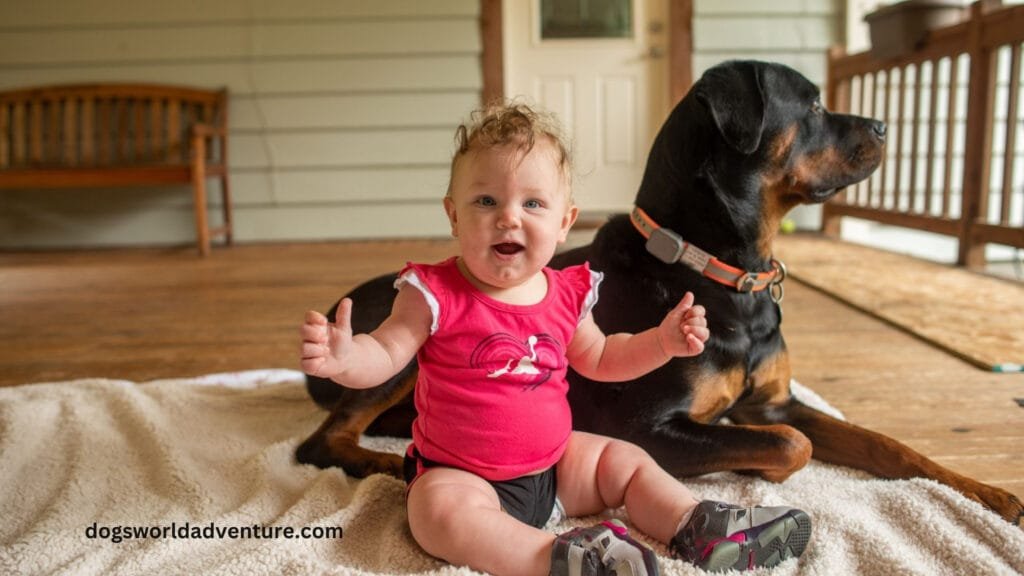
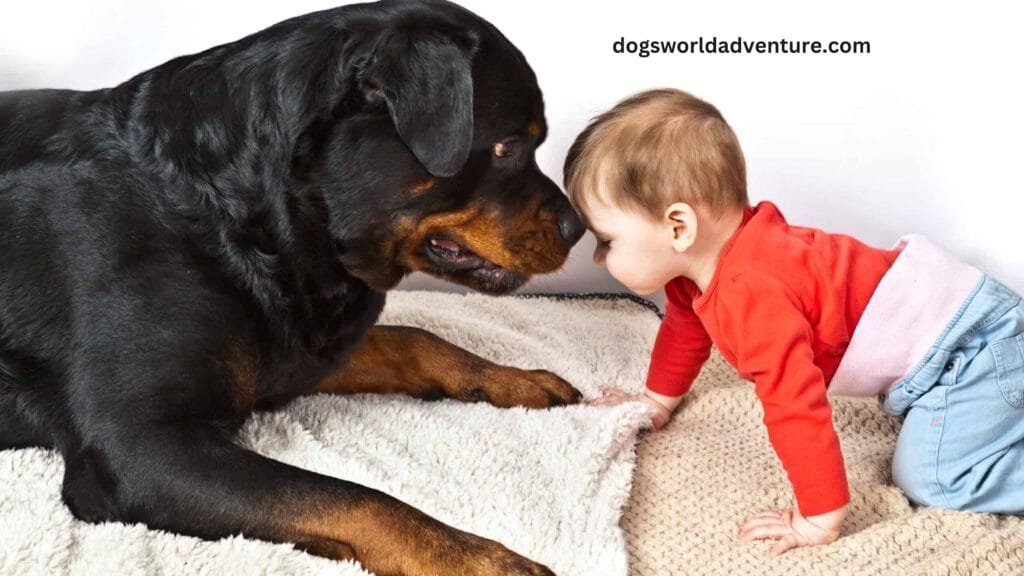
Rottweiler Training Tips
Training a Rottweiler is essential for ensuring they grow into well-behaved and balanced adults. Because of their size, strength, and protective nature, it’s important to start training early and remain consistent throughout their life.
Here are some key training tips for Rottweilers:
1. Start Early
It’s important to begin training your Rottweiler as a puppy. The earlier you start, the easier it will be to teach them good behavior. Puppies are more receptive to learning, and starting young will help prevent bad habits from forming.
2. Use Positive Reinforcement
Rottweilers respond well to positive reinforcement, which means rewarding them for good behavior. Use treats, praise, and affection to let them know they are doing the right thing. Avoid harsh punishments, as this can make them fearful or aggressive.
3. Be Consistent
Consistency is key when training a Rottweiler. Make sure everyone in your household follows the same rules and uses the same commands. This will help your dog understand what is expected of them and avoid confusion.
4. Socialize Your Rottweiler
Socialization is crucial for Rottweilers. Expose your dog to a variety of people, places, and experiences while they are young. This will help them become more confident and less fearful of new situations.
5. Enroll in Obedience Classes
If you’re unsure how to train your Rottweiler or if you’re having trouble with specific behaviors, consider enrolling in a professional obedience class. These classes can help you learn the best techniques for training your dog and provide your Rottweiler with an opportunity to socialize with other dogs.
Exercise Needs of a Rottweiler
Rottweilers are active dogs that require plenty of exercise to stay healthy and happy. Without enough physical activity, they can become bored and may develop destructive behaviors like chewing or digging.
A Rottweiler needs at least an hour of exercise each day. This can include walking, running, playing fetch, or even swimming. Rottweilers are strong and energetic, so they enjoy activities that challenge both their body and mind.
In addition to regular exercise, Rottweilers also need mental stimulation. They are intelligent dogs and love to solve puzzles or learn new commands. Providing them with toys that challenge their brain, like treat-dispensing toys or interactive games, can help prevent boredom.
If you live in a home with a yard, your Rottweiler will enjoy having space to run and play. However, they should not be left outside for long periods without supervision. Rottweilers thrive on human interaction and need to feel like they are part of the family.
Rottweiler Health and Lifespan
Rottweilers are known for their strength and resilience, but like all breeds, they are susceptible to certain health issues. Understanding the potential health concerns and taking preventive measures can help ensure your Rottweiler lives a long, healthy life.
Average Lifespan
The typical lifespan of a Rottweiler is around 8 to 10 years, but with proper care, some may live beyond this range. Like other large breeds, Rottweilers tend to have shorter lifespans compared to smaller dogs. However, keeping your dog in good health through regular vet visits, exercise, and a balanced diet can increase their chances of living a longer life.
Common Health Issues in Rottweilers
- Hip Dysplasia: This is a genetic condition where the hip joint doesn’t fit into the socket correctly, causing pain, lameness, and eventually arthritis. While it’s hereditary, factors like rapid growth, improper exercise, and excess weight can worsen the condition. To help manage or prevent hip dysplasia, make sure your Rottweiler has proper nutrition and exercise, and avoid over-exercising them during puppyhood.
- Elbow Dysplasia: Similar to hip dysplasia, this condition affects the elbow joints, causing pain and stiffness. It’s also genetic and can lead to arthritis if not treated early. Regular vet check-ups can help catch early signs of joint issues, and maintaining a healthy weight can reduce the strain on your dog’s joints.
- Aortic Stenosis: This is a heart condition that Rottweilers are prone to. It occurs when the aorta, the large blood vessel that carries blood from the heart to the body, is narrowed. This makes the heart work harder to pump blood, which can lead to heart failure over time. Signs of heart disease include fatigue, fainting, and difficulty breathing. Regular vet check-ups and heart screenings can help detect this condition early.
- Cancer: Unfortunately, cancer is a common cause of death in Rottweilers, particularly bone cancer (osteosarcoma). It typically affects older dogs, but regular vet visits and monitoring for unusual lumps or behavioral changes can help catch it early. Early detection is key in treating cancer effectively.
- Obesity: Rottweilers are large dogs that love to eat, making them prone to obesity if their diet isn’t managed properly. Obesity can lead to a number of health problems, including diabetes, heart disease, and joint issues like arthritis. To prevent obesity, feed your Rottweiler a well-balanced diet and ensure they get plenty of exercise. Avoid giving too many treats or table scraps, and stick to portion control to keep them at a healthy weight.
- Gastric Dilatation-Volvulus (Bloat): Bloat is a serious and potentially life-threatening condition that affects large, deep-chested dogs like Rottweilers. It occurs when the stomach fills with gas, fluid, or food and twists, trapping the contents inside. Symptoms include restlessness, a swollen abdomen, excessive drooling, and attempts to vomit without success. Bloat requires emergency treatment, and feeding your dog smaller meals and avoiding strenuous exercise after meals can help reduce the risk.
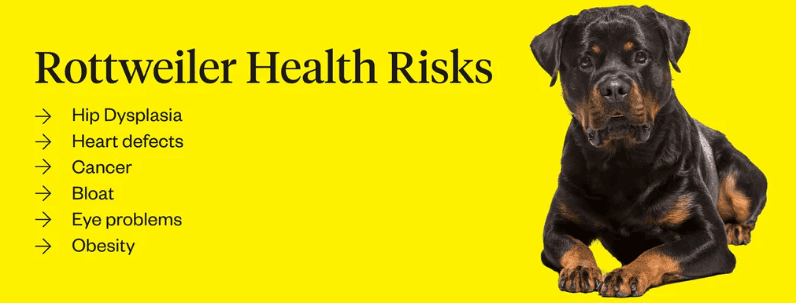
Preventive Care Tips
- Regular Vet Visits: Routine check-ups allow your vet to monitor your Rottweiler’s health, catch potential issues early, and administer vaccines and preventive medications (like heartworm and flea/tick preventives).
- Balanced Diet: Feed your Rottweiler high-quality dog food that is appropriate for their age, size, and activity level. Puppies need food that supports healthy growth, while adults need food that maintains their weight and muscle tone.
- Exercise: Regular exercise helps keep your Rottweiler’s muscles strong, supports joint health, and prevents obesity. Aim for at least 1 hour of physical activity per day, whether it’s walking, running, or playing.
- Joint Supplements: As your Rottweiler ages, consider giving them joint supplements (such as glucosamine and chondroitin) to help maintain healthy joints and prevent arthritis.
- Weight Management: Keeping your Rottweiler at a healthy weight reduces the risk of joint issues, heart disease, and other obesity-related health problems. Stick to the feeding guidelines on your dog’s food packaging and adjust as necessary based on their activity level and body condition.
Extending Your Rottweiler’s Life
To help your Rottweiler live as long and healthy a life as possible, it’s important to monitor their health closely and provide them with the right care. This includes ensuring they eat a nutritious diet, stay active, and see the vet regularly. Early detection of health issues can make a huge difference, so watch for signs like limping, changes in behavior, or weight gain.
By providing your Rottweiler with love, care, and attention, you’ll give them the best chance to live a happy, healthy life for as many years as possible.
Rottweiler Grooming Needs
Rottweilers are relatively low-maintenance when it comes to grooming. Their short, dense coat doesn’t require frequent trips to the groomer, but regular brushing is important. Brushing your Rottweiler’s coat once or twice a week will help remove loose hair and keep their skin healthy.
Here are a few key grooming tips:
1. Brushing
Rottweilers shed moderately throughout the year and experience heavier shedding in the spring and fall. A soft-bristle brush or a rubber grooming mitt works well to remove loose fur and prevent excessive shedding.
2. Bathing
Rottweilers don’t need frequent baths. A bath every 6 to 8 weeks is typically enough to keep their coat clean. Be sure to use a dog-specific shampoo, as human shampoos can dry out their skin. If your Rottweiler gets especially dirty or smelly, you can bathe them more often, but try to avoid over-bathing, as it can strip the natural oils from their coat.
3. Nail Trimming
Regular nail trimming is essential for a Rottweiler. If their nails grow too long, they can become painful and affect their ability to walk comfortably. Trim their nails every few weeks, or as needed, depending on how quickly they grow. You can do this yourself or take them to a groomer or vet for assistance.
4. Ear Cleaning
Check your Rottweiler’s ears weekly for signs of dirt, wax buildup, or infection. Wipe the inside of their ears with a damp cloth or a vet-recommended ear cleaner to prevent infections. Avoid sticking anything deep inside the ear canal, as this can cause injury.
5. Dental Care
Like all dogs, Rottweilers need regular dental care. Brushing your dog’s teeth several times a week helps prevent plaque buildup and gum disease. You can also offer dental chews or toys designed to clean their teeth as they chew.
Feeding Your Rottweiler
A well-balanced diet is essential for keeping your Rottweiler healthy. Due to their size and strength, Rottweilers require high-quality food that provides all the necessary nutrients.
Here’s what you need to know about feeding your Rottweiler:

1. Puppy Feeding
Rottweiler puppies need a diet that supports their rapid growth and development. A puppy-specific food, particularly one designed for large breeds, will ensure they get the right balance of protein, fat, and vitamins. Puppies should be fed three to four times a day to help manage their energy levels and avoid overeating.
2. Adult Feeding
As your Rottweiler grows into adulthood (around 18-24 months), their diet should shift to adult dog food. Look for a food that is formulated for large breeds, as these typically have the right balance of nutrients for a dog of their size. Adult Rottweilers should be fed twice a day.
3. Portion Control
Rottweilers can easily gain weight if they are overfed, so it’s important to measure their food portions. Always follow the guidelines on the dog food packaging, and adjust as needed based on your dog’s activity level and body condition. Avoid feeding your Rottweiler table scraps, as this can lead to obesity and digestive issues.
4. Treats and Supplements
Treats are a great way to reward your Rottweiler during training, but be mindful of how many treats you give. Too many can add unnecessary calories to their diet. Choose healthy, low-calorie treats, and use them sparingly. Some Rottweilers may also benefit from joint supplements, especially as they age, to help maintain healthy joints and mobility.
Common Misconceptions About Rottweilers
Rottweilers often get a bad reputation due to misunderstandings about their temperament and behavior. Let’s clear up some common misconceptions about this breed:
1. Rottweilers Are Aggressive
Many people assume that Rottweilers are aggressive because of their strong, imposing appearance. While it’s true that Rottweilers can be protective, they are not inherently aggressive. Like any dog, their behavior depends on their training and socialization. A well-trained and socialized Rottweiler is calm, confident, and friendly.
2. Rottweilers Are Dangerous
Another misconception is that Rottweilers are dangerous dogs. While they are strong and protective, they are not dangerous when raised in a loving environment with proper training. It’s important to remember that any dog, regardless of breed, can be dangerous if not properly trained or cared for.
3. Rottweilers Don’t Get Along with Other Dogs
Rottweilers can get along well with other dogs if they are properly socialized from a young age. Early exposure to other animals helps them learn to interact appropriately. However, because Rottweilers are naturally dominant, they may not always get along with other dominant dogs. Supervision and proper introductions are key.
4. Rottweilers Don’t Make Good Family Pets
This is simply not true! Rottweilers can make excellent family pets when they are raised in a loving, structured environment. They are loyal, protective, and affectionate with their families. With proper training, they can be gentle and patient with children.
Conclusion
The Rottweiler is a strong, loyal, and loving dog that makes an incredible companion when properly trained and cared for. Their history as working dogs has given them a protective instinct, but with early training and socialization, they can be gentle and affectionate pets. Whether you’re looking for a family dog, a working dog, or a protective companion, the Rottweiler is a breed that offers strength, intelligence, and loyalty.
While owning a Rottweiler comes with responsibilities, the rewards are immense. By understanding their needs for exercise, training, socialization, and care, you can raise a happy and well-behaved Rottweiler that will bring joy to your home for years to come.
Read also: Doberman Pinscher
FAQs
1. Are Rottweilers good with children?
Yes, Rottweilers can be great with children, especially when they are properly trained and socialized. They are protective and gentle, but supervision is always recommended due to their size and strength.
2. How much exercise does a Rottweiler need?
Rottweilers need at least an hour of exercise every day. This can include walking, playing, or other activities that challenge them both physically and mentally.
3. Are Rottweilers aggressive?
Rottweilers are not naturally aggressive. They are protective and loyal but can become aggressive if they feel threatened or are not properly trained. Early socialization and training are key to preventing aggression.
4. Do Rottweilers shed a lot?
Rottweilers shed moderately throughout the year and more heavily in the spring and fall. Regular brushing will help control shedding and keep their coat healthy.
5. How long do Rottweilers live?
The average lifespan of a Rottweiler is 8 to 10 years. With proper care, some Rottweilers may live longer.
6. Do Rottweilers get along with other dogs?
Rottweilers can get along well with other dogs if they are socialized from a young age. However, because they are naturally dominant, they may not always get along with other dominant dogs.
7. How much does a Rottweiler weigh?
Adult Rottweilers typically weigh between 80 and 135 pounds, with males being larger and more muscular than females.
8. Are Rottweilers easy to train?
Rottweilers are intelligent and eager to please, making them relatively easy to train. However, they require consistent, positive reinforcement and early training to ensure they learn good behavior.
9. Do Rottweilers need a lot of grooming?
Rottweilers are low-maintenance when it comes to grooming. Regular brushing and occasional baths are usually enough to keep their coat in good condition.
10. What is the history of the Rottweiler?
Rottweilers originated from Roman herding dogs and were later used in Germany to drive cattle and guard butcher’s carts. Their history as working dogs has given them a strong and protective nature.

